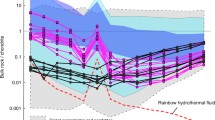Abstract
We have measured helium isotopic ratios of thirty-seven Pacific water samples from various depths collected in adjacent regions of Honshu, Japan. The 3He/4He ratios vary significantly from 0.989 R atm to 1.208 R atm where R atm is the atmospheric ratio of 1.39 × 10−6. The mid-depth (750–1500 m) profile of 3He/4He ratios at ST-1 located Northwestern Pacific Ocean east of Japan (Off Joban; 37°00′ N, 142°40′ E) is significantly different from that at ST-2 of the Northern Philippine Sea south of Japan (Nankai Trough; 33°07′ N, 139°59′ E), suggesting that these waters were separated by a topographic barrier, the Izu-Ogasawara Ridge. Taking 3He/4He data of the Geosecs expeditions in the western North Pacific, an extensive plume of 15% excess 3He relative to the air may be traced at ST-1 over 12,000 kilometers to the northwest of the East Pacific Rise where the mantle helium may originate. The 20% excess found at ST-2 may be attributable to the additional source of the subduction-type mantle helium in the Okinawa Trough. A 15% excess of 3He has also been discovered at a depth of about 1000∼1500 m at ST-3 adjacent to Miyakejima Island (33°57′ N, 139°22′ E) and ST-4 of Sagami Bay (35°00′ N, 139°22′ E). It is confirmed that mid-depth all over the western North Pacific water is affected by the mantle helium with a high 3He/4He ratio.
Similar content being viewed by others
References
Benson, B. B. and D. Krause, Jr. (1980): Isotope fractionation of helium during solution: a probe for the liquid state. J. Solution Chem., 9, 895–909.
Craig, H. and W. B. Clarke (1970): Oceanic 3He: Contribution from cosmogenic tritium. Earth Planet. Sci. Lett., 9, 45-48.
Craig, H., W. B. Clarke and M. A. Beg (1975): Excess 3He in deep water on the East Pacific Rise. Earth Planet. Sci. Lett., 26, 125–132.
Fujio, S., T. Kadowaki and N. Imasato (1992): World ocean circulation diagnostically derived from hydrographic and wind stress fields. Part 1: The velocity field. J. Geophys. Res., 97, 11163–11176.
Igarashi, G., M. Kodera, M. Ozima, Y. Sano and H. Wakita (1987): Noble gas elemental and isotopic abundances in deep sea trench in the West Pacific. Earth Planet. Sci. Lett., 86, 77–84.
Ishibashi, J., T. Gamo, H. Sakai, Y. Nojiri, G. Igarashi, K. Shitashima and H. Tsubota (1988): Geochemical evidence for hydrothermal activity in the Okinawa Trough. Geochem. J., 22, 107–114.
Ishibashi, J., Y. Sano, H. Wakita, T. Gamo, M. Tsutsumi and H. Sakai (1995): Helium and carbon geochemistry of hydrothermal fluids from the Mid-Okinawa Trough Back Arc Basin, southwest of Japan. Chem. Geol., 123, 1–15.
Jenkins, J. E. and W. B. Clarke (1976): The distribution of 3He in the western Atlantic Ocean. Deep Sea Res. Oceanogr. Abstr., 23, 481–494.
Jenkins, J. E., M. A. Beg, W. B. Clarke, P. J. Wangersky and H. Craig (1972): Excess 3He in the Atlantic Ocean. Earth Planet. Sci. Lett., 16, 122–126.
Lupton, J. E. (1983): Terrestrial inert gases: Isotope tracer studies and clues to primordial components in the mantle. Ann. Rev. Earth Planet. Sci., 11, 371–414.
Lupton, J. E. (1995): Hydrothermal plumes: Near and far field. p. 317–346. In Seafloor Hydrothermal Systems: Physical, Chemical, Biological and Geological Interactions, Geophysical Monograph 91, American Geophysical Union, Washington, D.C.
Lupton, J. E. and H. Craig (1981): A major helium-3 source at 15?S on the East Pacific Rise. Science, 214, 13–18.
Mamyrin, B. A. and I. N. Tolstikhin (1984): Helium Isotopes in Nature. Elsevier, Amsterdam, 273 pp.
Mizuno, K. and W. B. White (1983): Annual and interannual variability in the Kuroshio current system. J. Phys. Oceanogr., 13, 1847–1867.
Östlund, H., H. Craig, W. S. Broecker and D. Spencer (1987): Shorebased data and graphics. GEOSECS Atlantic, Pacific and Indian Ocean Expeditions, Volume 7.
Pacific Marine Environmental Laboratory (2003): Home page of Vent Program. www.pmel.noaa.gov/vents Rison, W. and H. Craig (1983): Helium isotopes and mantle volatiles in Loihi Seamount and Hawaiian Island basalts and xenoliths. Earth Planet. Sci. Lett., 66, 407–426.
Sano, Y. andH. Wakita (1985): Geographical distribution of 3He/4He ratios in Japan: Implications for arc tectonics and incipient magmatism. J. Geophys. Res., 90, 8729–8741.
Sano, Y. and H. Wakita (1988): Precise measurement of helium isotopes in terrestrial gases. Bull. Chem. Soc. Japan, 61, 1153–1157.
Sano, Y., H. Wakita, J. Ishibashi, T. Gamo and H. Sakai (1989): Helium isotope ratios in Japan Sea water. Chikyukagaku(Geochemistry), 23, 61–67 (in Japanese with English abstract).
Sano, Y., N. Takahata and T. Gamo (1995): Helium isotopes in South Pacific deep seawater. Geochem. J., 29, 377–384.
Sano, Y., Y. Nishio, S. Sasaki, T. Gamo and K. Nagao (1998): Helium and carbon isotope systematics at Ontake volcano, Japan. J. Geophys. Res., 103, 23863–23873.
Stommel, H. and A. B. Arons (1960): On the abyssal circulation of the world ocean. Part II-An idealized model of circulation pattern and amplitude in oceanic basins. Deep-Sea Res., 6, 217–233.
Terai, K., T. Yabuki, N. Sasahara, K. Kawai, K. Fukano, M. Sato and A. Sengoku (2001): Crustal movement of observation at small islands in Izu Shoto and crustal movements of adjacent sea area by Miyake-jima eruption. Report of Hydrogr. Res., 37, 73–86 (in Japanese with English abstract).
Weiss, R. F. (1971): Solubility of helium and neon in water and seawater. J. Chem. Eng. Data, 16, 235–241.
Author information
Authors and Affiliations
Corresponding author
Rights and permissions
About this article
Cite this article
Sano, Y., Kosugi, T., Takahata, N. et al. Helium Isotopes in Pacific Waters from Adjacent Region of Honshu, Japan. Journal of Oceanography 60, 625–630 (2004). https://doi.org/10.1023/B:JOCE.0000038354.11963.b8
Issue Date:
DOI: https://doi.org/10.1023/B:JOCE.0000038354.11963.b8




